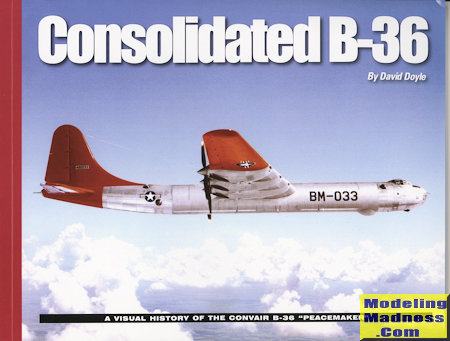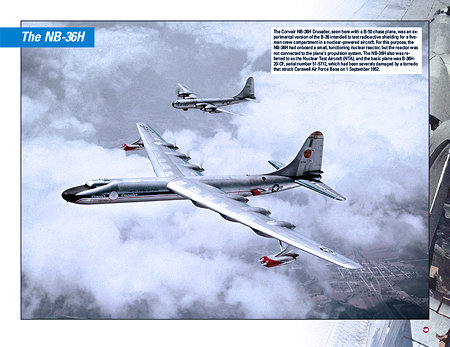Ampersand's Consolidated B-36
|
BY: |
David Doyle |
|
PUBLISHER
/PRICE: |
Ampersand
$22.95 |
|
REVIEW BY: |
Scott
Van Aken |
| NOTES: |
120 pages, softcover, landscape, ISBN 978-0-9861127-2-0 |
 This next book
in their visual history series is this very nicely done book on the largest
bomber ever built, the Consolidated B-36. The initial bid for what would be
America's first intercontinental bomber was placed, none of the companies who
responded were able to meet the speed/range/payload requirements. In truth, they
were asking for too much. Once these were toned down, several companies were
able to submit proposals and it was Consolidated that won the contract. Though
planned on having a first flight in May 1944, the actual first flight was
delayed for a number of reasons until 3 1/2 years later in December 1947. Those
of us who have been around a while, realize that very few planes have actually
met contract requirements in this and other regards. I have a feeling that those
requesting these things realize that when dealing with something this new, it
would not meet initial requirements. We see that only so well in the current
F-35 program.
This next book
in their visual history series is this very nicely done book on the largest
bomber ever built, the Consolidated B-36. The initial bid for what would be
America's first intercontinental bomber was placed, none of the companies who
responded were able to meet the speed/range/payload requirements. In truth, they
were asking for too much. Once these were toned down, several companies were
able to submit proposals and it was Consolidated that won the contract. Though
planned on having a first flight in May 1944, the actual first flight was
delayed for a number of reasons until 3 1/2 years later in December 1947. Those
of us who have been around a while, realize that very few planes have actually
met contract requirements in this and other regards. I have a feeling that those
requesting these things realize that when dealing with something this new, it
would not meet initial requirements. We see that only so well in the current
F-35 program.
In order to be able to meet weight
requirements, most of the airframe was built from magnesium. This works very
well for lightness, but it is incapable of very much flexing and so the
pressurized areas of the airframe were made of aluminum. When you look at B-36
images, you can plainly see the shiny aluminum nose section compared to the
duller magnesium. Once the XB-36 first flew, it was realized that, thanks to the
large single tire main landing gear that there were only three places in the US
that had runways strong enough to bear the pressure so a multiple wheel bogie
was soon developed to replace that. Other changes were made, including a
different cockpit section.
Eventually the B-36 entered series
production, though the production lots were not very large. Capabilities in
equipment were improved and to help the aircraft get off the ground fully
loaded, it finally sprouted a pair of jet engines under each wing. These were
specially developed to run on avgas rather than jet fuel. They also had the
ability to close the intake to cut back on drag when not used, though a small
hole was still left so the engines could properly windmill for restarts.
As the equipment increased, so did the
weight so several programs were developed to reduce overall weight. All but the
tail guns were eventually removed as were crew comfort things like sound
insulation and cots for the relief crew. Many older versions were upgraded as
much as possible. A rather interesting fact is that only one B-36 that crash
landed was ever returned to service. Usually unexpected landings broke the plane
into too many pieces to make it worth rebuilding.
 The B-36
was a great recce platform, able to carry very large cameras and to be able to
change film in flight. It was also used for a number of experimental projects
including the X-6 which carried a functioning nuclear reactor as part of a
program to develop nuclear engines, though the reactor did not power the
aircraft. A jet version of the B-36, the XB-60 was developed as well, though
never made it past prototype. Same with the huge XC-99 based on B-36 flight
surfaces. The last B-36 was delivered in 1955 and the type started being retired
from service in 1956 with the last one gone during 1959. The slowness of the
aircraft and its inability to be refueled in flight were major reasons for its
retirement. Ten years of active service sure left an indelible imprint in
people's minds.
The B-36
was a great recce platform, able to carry very large cameras and to be able to
change film in flight. It was also used for a number of experimental projects
including the X-6 which carried a functioning nuclear reactor as part of a
program to develop nuclear engines, though the reactor did not power the
aircraft. A jet version of the B-36, the XB-60 was developed as well, though
never made it past prototype. Same with the huge XC-99 based on B-36 flight
surfaces. The last B-36 was delivered in 1955 and the type started being retired
from service in 1956 with the last one gone during 1959. The slowness of the
aircraft and its inability to be refueled in flight were major reasons for its
retirement. Ten years of active service sure left an indelible imprint in
people's minds.
In this
book by David Doyle, we are given a short history of the type including all the
various test aircraft. The vast majority of the book consists of photographs, a
few of them taken during the construction of the aircraft. We are provided with
details of the various systems and each variant has its own section. Since it is
a visual history, Ampersand Publishing has picked out the best images and the
landscape format allows for some large images, some of them in full color. It is a book I thoroughly enjoyed reading and is one that I can
easily recommend to you.
February 2016
Copyright ModelingMadness.com
Review copy courtesy
Ampersand Publishing.
Get yours today
at this link.
If you would like your product reviewed fairly and
fairly quickly, please contact
the editor or see other details in the
Note to
Contributors.
 This next book
in their visual history series is this very nicely done book on the largest
bomber ever built, the Consolidated B-36. The initial bid for what would be
America's first intercontinental bomber was placed, none of the companies who
responded were able to meet the speed/range/payload requirements. In truth, they
were asking for too much. Once these were toned down, several companies were
able to submit proposals and it was Consolidated that won the contract. Though
planned on having a first flight in May 1944, the actual first flight was
delayed for a number of reasons until 3 1/2 years later in December 1947. Those
of us who have been around a while, realize that very few planes have actually
met contract requirements in this and other regards. I have a feeling that those
requesting these things realize that when dealing with something this new, it
would not meet initial requirements. We see that only so well in the current
F-35 program.
This next book
in their visual history series is this very nicely done book on the largest
bomber ever built, the Consolidated B-36. The initial bid for what would be
America's first intercontinental bomber was placed, none of the companies who
responded were able to meet the speed/range/payload requirements. In truth, they
were asking for too much. Once these were toned down, several companies were
able to submit proposals and it was Consolidated that won the contract. Though
planned on having a first flight in May 1944, the actual first flight was
delayed for a number of reasons until 3 1/2 years later in December 1947. Those
of us who have been around a while, realize that very few planes have actually
met contract requirements in this and other regards. I have a feeling that those
requesting these things realize that when dealing with something this new, it
would not meet initial requirements. We see that only so well in the current
F-35 program.  The B-36
was a great recce platform, able to carry very large cameras and to be able to
change film in flight. It was also used for a number of experimental projects
including the X-6 which carried a functioning nuclear reactor as part of a
program to develop nuclear engines, though the reactor did not power the
aircraft. A jet version of the B-36, the XB-60 was developed as well, though
never made it past prototype. Same with the huge XC-99 based on B-36 flight
surfaces. The last B-36 was delivered in 1955 and the type started being retired
from service in 1956 with the last one gone during 1959. The slowness of the
aircraft and its inability to be refueled in flight were major reasons for its
retirement. Ten years of active service sure left an indelible imprint in
people's minds.
The B-36
was a great recce platform, able to carry very large cameras and to be able to
change film in flight. It was also used for a number of experimental projects
including the X-6 which carried a functioning nuclear reactor as part of a
program to develop nuclear engines, though the reactor did not power the
aircraft. A jet version of the B-36, the XB-60 was developed as well, though
never made it past prototype. Same with the huge XC-99 based on B-36 flight
surfaces. The last B-36 was delivered in 1955 and the type started being retired
from service in 1956 with the last one gone during 1959. The slowness of the
aircraft and its inability to be refueled in flight were major reasons for its
retirement. Ten years of active service sure left an indelible imprint in
people's minds.